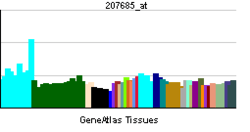CRYBB3
Beta-crystallin B3 is a protein that in humans is encoded by the CRYBB3 gene.[3][4]
Crystallins are separated into two classes: taxon-specific, or enzyme, and ubiquitous. The latter class constitutes the major proteins of vertebrate eye lens and maintains the transparency and refractive index of the lens. Since lens central fiber cells lose their nuclei during development, these crystallins are made and then retained throughout life, making them extremely stable proteins. Mammalian lens crystallins are divided into alpha, beta, and gamma families; beta and gamma crystallins are also considered as a superfamily. Alpha and beta families are further divided into acidic and basic groups. Seven protein regions exist in crystallins: four homologous motifs, a connecting peptide, and N- and C-terminal extensions. Beta-crystallins, the most heterogeneous, differ by the presence of the C-terminal extension (present in the basic group, none in the acidic group). Beta-crystallins form aggregates of different sizes and are able to self-associate to form dimers or to form heterodimers with other beta-crystallins. This gene, a beta basic group member, is part of a gene cluster with beta-A4, beta-B1, and beta-B2.[4]
References
Further reading
- Aarts HJ, Jacobs EH, van Willigen G, et al. (1989). "Different evolution rates within the lens-specific beta-crystallin gene family". J. Mol. Evol. 28 (4): 313–21. doi:10.1007/BF02103427. PMID 2499686.
- Kramer P, Yount J, Mitchell T, et al. (1996). "A second gene for cerulean cataracts maps to the beta crystallin region on chromosome 22". Genomics. 35 (3): 539–42. doi:10.1006/geno.1996.0395. PMID 8812489.
- Kimoto Y (1997). "A possibility of all mRNA expression in a human single lymphocyte". Hum. Cell. 9 (4): 367–70. PMID 9183670.
- Dunham I, Shimizu N, Roe BA, et al. (1999). "The DNA sequence of human chromosome 22". Nature. 402 (6761): 489–95. doi:10.1038/990031. PMID 10591208.
- MacCoss MJ, McDonald WH, Saraf A, et al. (2002). "Shotgun identification of protein modifications from protein complexes and lens tissue". Proc. Natl. Acad. Sci. U.S.A. 99 (12): 7900–5. doi:10.1073/pnas.122231399. PMC 122992
 . PMID 12060738.
. PMID 12060738.
- Strausberg RL, Feingold EA, Grouse LH, et al. (2003). "Generation and initial analysis of more than 15,000 full-length human and mouse cDNA sequences". Proc. Natl. Acad. Sci. U.S.A. 99 (26): 16899–903. doi:10.1073/pnas.242603899. PMC 139241
 . PMID 12477932.
. PMID 12477932.
- Collins JE, Wright CL, Edwards CA, et al. (2005). "A genome annotation-driven approach to cloning the human ORFeome". Genome Biol. 5 (10): R84. doi:10.1186/gb-2004-5-10-r84. PMC 545604
 . PMID 15461802.
. PMID 15461802.
- Gerhard DS, Wagner L, Feingold EA, et al. (2004). "The Status, Quality, and Expansion of the NIH Full-Length cDNA Project: The Mammalian Gene Collection (MGC)". Genome Res. 14 (10B): 2121–7. doi:10.1101/gr.2596504. PMC 528928
 . PMID 15489334.
. PMID 15489334.
- Riazuddin SA, Yasmeen A, Yao W, et al. (2005). "Mutations in betaB3-crystallin associated with autosomal recessive cataract in two Pakistani families". Invest. Ophthalmol. Vis. Sci. 46 (6): 2100–6. doi:10.1167/iovs.04-1481. PMID 15914629.

 . PMID 12060738.
. PMID 12060738. . PMID 12477932.
. PMID 12477932. . PMID 15461802.
. PMID 15461802. . PMID 15489334.
. PMID 15489334.